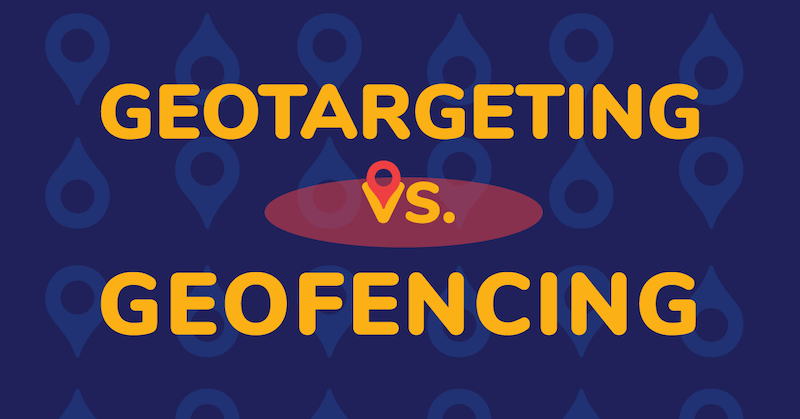Geotargeting vs. Geofencing – what’s the difference?

The extensive range of targeting capabilities is one of the primary benefits of digital advertising. The more criteria you layer, the more likely you are to find your audience. One of the most important factors you can consider is location targeting. Location targeting helps to ensure that you are reaching your audience with ads that are timely and relevant – which, of course, gives you a better chance of converting them into a customer.
Two of the most common types of location targeting include geofencing and geotargeting. You may have heard these terms used interchangeably. Or perhaps you’ve heard them both and not realized there was a difference. Both are powerful tools to have in your advertising arsenal, but they’re definitely not the same!
We’ve already walked you through the basics of geofencing. This time, we’ll be tackling a different question: what’s the difference between geotargeting vs. geofencing, anyway? Let’s dive in.
What is geotargeting?
Simply put, geotargeting is used to reach audiences based on their location. It can be as tightly focused as a zip code or as wide as a country, and it is almost always layered with other forms of targeting. For example: if you were an online retailer of boating supplies, you probably wouldn’t want to target landlocked areas. You would want to focus on regions that have lakes and beaches. However, you would also want to layer in other factors, such as age, household income, and affinity for boating.

Examples of geotargeting
- A zoo hosting an event could target potential visitors within a 50-mile radius of their location.
- An online retailer could target areas that get snow with ads for warm winter coats.
- A food delivery company could use weather-based targeting to advertise free delivery in an area where it’s cold or raining, when people don’t want to venture out to get food.
When is geotargeting right for you?
Almost every single advertising campaign will have some form of geotargeting layered in. It can be used for both brick-and-mortar businesses looking to drive in-person visits or online shops looking to target certain demographics, and everything in between. Geotargeting can’t usually carry an entire campaign on its own, but when layered with other targeting criteria, it is a powerful and essential tool.
What is geofencing?
Generally, geofencing is used when the area you want to target is very tight and specific. A “fence” is created around the desired area, and your audience’s location is tracked using cellular data, GPS, Wi-fi, or RFID. Once they have crossed the line and are inside the “fence,” they can be served an ad, which could take the form of display creative, a push notification, or more. For example, let’s say your company is presenting at an expo, and you want to run ads that direct attendees to your booth. If you geotargeted the whole city where the expo was held, you would likely be wasting your advertising dollars reaching an audience that isn’t even attending the expo. If you target the area immediately around the event, however, you’ll be much more likely to reach your intended audience.

Examples of geofencing
- A pizza parlor could geofence the blocks surrounding their locations and offer customers a coupon to entice them to order when they’re in the area.
- A hair salon could geofence the area around their closest competitors and serve their audience an ad.
- A grocery store could enable geofencing to track when a customer is nearing the store to pick up their grocery order.
When is geofencing right for you?
If you are running a campaign that is tied to a very specific location, such as a brick-and-mortar store (yours or your competitor’s) or an in-person event, geofencing can be a powerful tool. Geofencing will reach a smaller audience than geotargeting, generally. But the ads will be much more likely to feel relevant to that audience, since they will relate to their immediate surroundings.
As you can see, both tactics are very useful to have in your advertising arsenal – but their usefulness depends on what you’re trying to accomplish. In the right hands, location targeting – whether that’s hyper-specific geofencing or tried-and-true geotargeting – can bring your campaign to the next level.


